
Killer whales killing a gray whale. Contemporary walrus tusk carving, Anadyr City Museum, Chukotka, Russia.Chukchi Art
Chukotka is the part of Siberia located just across the Bering Strait from Alaska. It is one of the most interesting provinces of Russia, with diverse and beautiful Nature, and relatively well-preserved traditional culture. It is about 15% larger than France or Texas, and mostly covered with low mountains and the tundra.
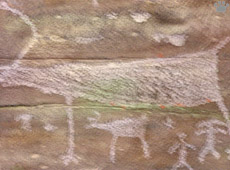 |
 |
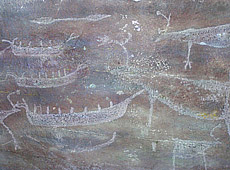 |
| Stone Age petroglyphs, Anadyr City Museum, Chukotka. |
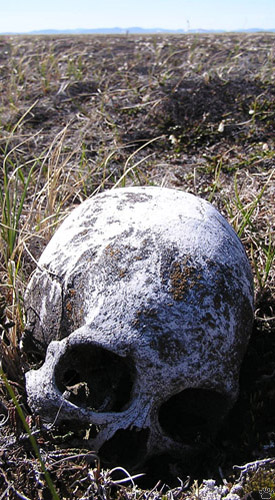
Ancient legends and archeological evidence suggest that Chukchi
takeover of Chukotka was anything but peaceful. They almost drove
the Yupik Eskimos out of Asia, and the numbers of Yukagir and
Lamut people fell to the low hundreds. Belyaka Spit, Chukotka. |
The Chukchi are by far the largest native ethnic group of Chukotka: they number about 15,000. They are unusual among the Northern peoples in having two distinct cultures: the nomadic reindeer herders (chauchu), and the village-based marine mammal hunters (ankalyn). Unlike other native groups of Siberia, they were fiercely militant, and have never been conquered by Russian troops. They joined the Russian Empire voluntarily in the 19th century. Under the Soviet rule, they endured mass imprisonment and the destruction of the traditional culture. |
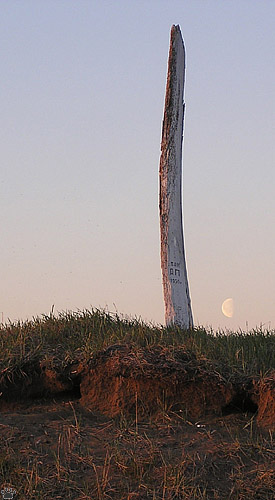
Jawbone of a bowhead whale and a hill riddled with Arctic fox
burrows mark the site of an abandoned Chukchi village on the
Arctic coast. Such places often have unusually high biodiversity.
Belyaka Spit, Chukotka. |
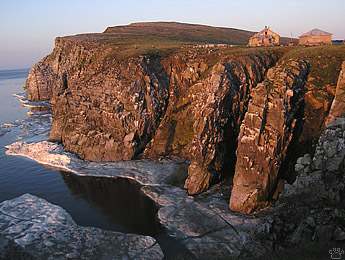
Abandoned Soviet research station, Kolyuchin Island, Chukotka. |
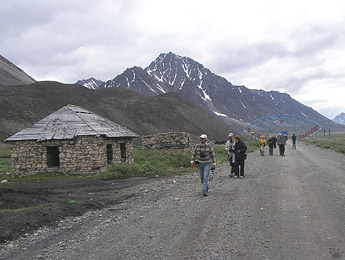
Tourists exploring guards' cabins at a small GULAG site, Egvenkinot-Amguema Rd. |

Town of Egvenkinot. |
After decades of mining and heavy military presence, Russians are now mostly working in transportation, trade and all- paralyzing bureaucracy. |

Town of Egvenkinot. |
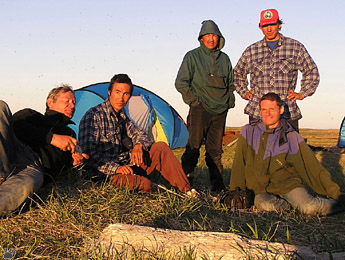
Author with seal hunters from Nutepelmen Village. |
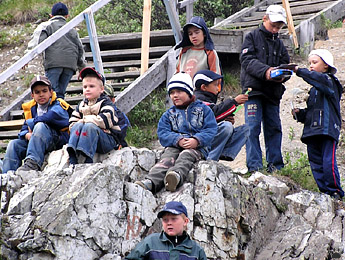
Russian and Azeri kids, Egvenkinot. |
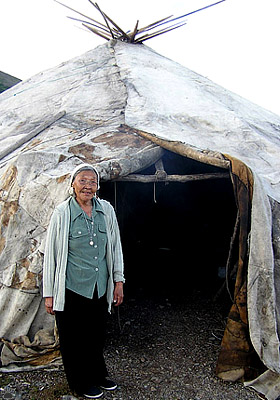
Yaranga of Vladimir Sertoon, Dionisia Mt. |
Yaranga is the traditional home of Chukchi reindeer herders. It's been used by the chauchi for at least a few hundred years. On the outside, yaranga looks similar to the yurtas of Kyrgyz and Kazakh nomads, and the ger of Mongols. But the interior structure of all of them is different. It takes about 80 reindeer skins to build a yaranga. Wooden poles are mostly imported. |
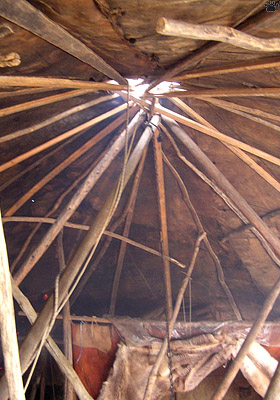
Yaranga roof from the inside. |
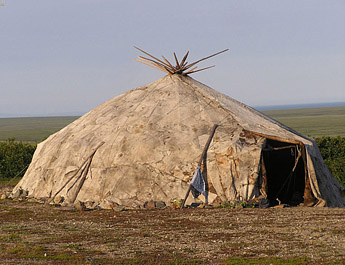 |
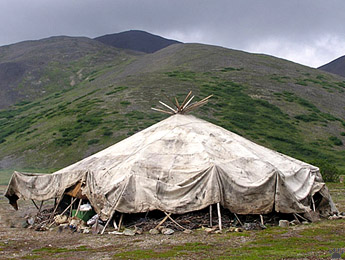 |
| Chukchi yaranga. In summer, you can pull up the sides for better ventilation. Dionisia Mt. |
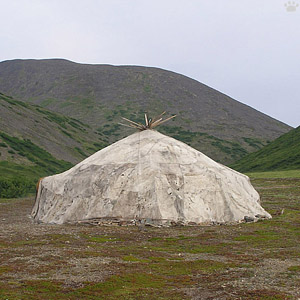
Yarangas always beautifully match the landscape. |
It would be difficult to heat up the entire yaranga in winter, so people sleep in polog - a little deerskin cabin inside the yaranga, very cozy and warm. |

Fireplace and polog inside yaranga. |
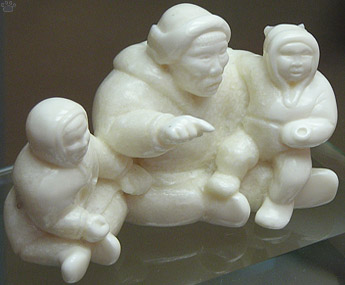 |
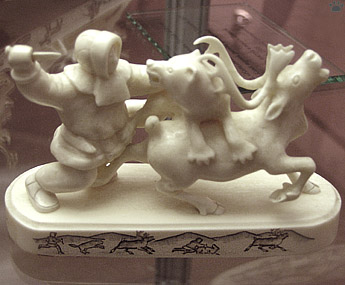 |
| Storyteller (left); shepherd defending his reindeer from wolves (right). Contemporary walrus tusk carvings, Anadyr City Museum. |
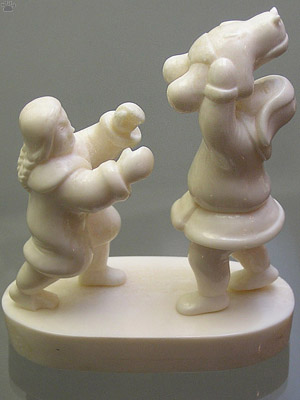
Returning hunter. Contemporary walrus tusk carvings, ACM. |
The Chukchi have always been famous for their boat-and clothing-making skills. In recent decades, they took up bone- carving. The oldest form was small sculptures cut from walrus tusk, similar to the ancient art of the Eskimo peoples. |

Necklace. Seal skin, beads. Bought in a souvenir shop in Anadyr. |

Carved walrus tusk, contemporary, ACM. |

Old carved walrus tusk, c. 1960, ACM. |
Later, surface carving became popular. |

Carved tusk showing the governor's arrival, c. 2004, ACM. |
 |
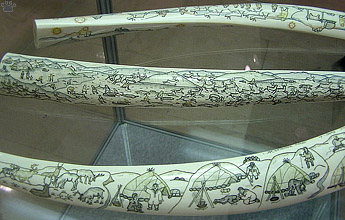 |
| Carved walrus tusks, contemporary, ACM. |
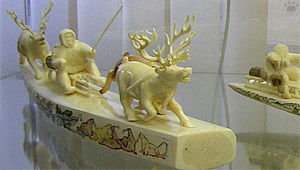
Contemporary walrus tusk and mammoth ivory carving, ACM. |
Today the most expensive pieces are the ones combining relief and sculpture |
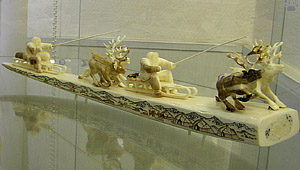
Contemporary walrus tusk and mammoth ivory carving, ACM. |
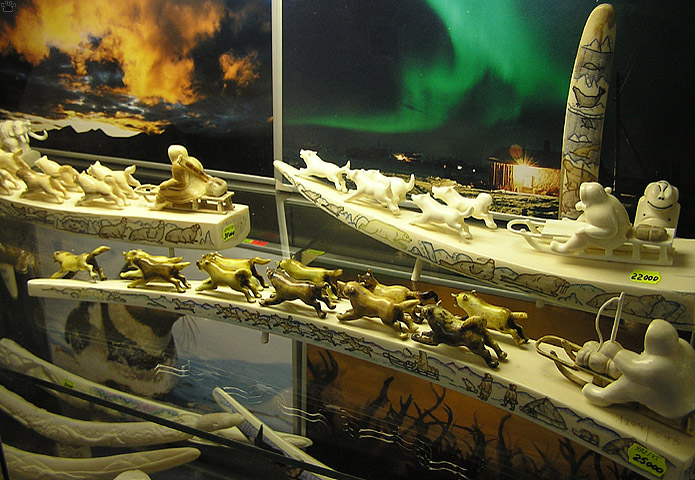
Contemporary carvings made of walrus tusk (mammoth ivory is used for darker pieces) in a souvenir shop in Anadyr. |

Contemporary whale vertebra carving, ACM. |
The most recent invention is carving of whale vertebrae. Most of bone-carving is done in a workshop in Uelen village on the Arctic coast. |
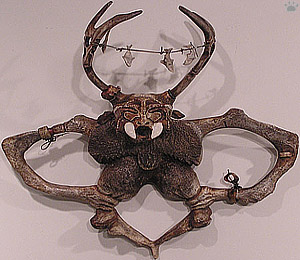
Contemporary whale vertebra carving, ACM. |
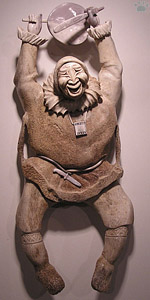
Contemporary whale vertebra
carving, ACM. |
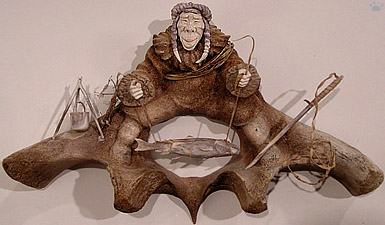
Contemporary whale vertebra carving, ACM. |
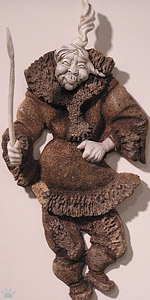
Contemporary whale vertebra
carving, ACM. |
| With Russian influence somewhat diminishing and the economy improving, traditional culture is experiencing a slow revival. Hopefully it will survive, unlike most other traditional cultures of Siberia. |
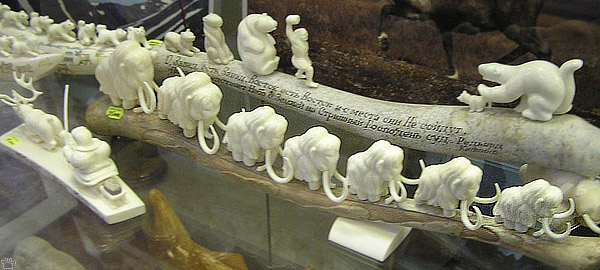
Contemporary carvings, walrus tusk and penal bones, in a souvenir shop in Anadyr. The carved quote is from R. Kipling:
Oh, East is East, and West is West, and never the twain shall meet,
Till Earth and Sky stand presently at God's great Judgment Seat... |
Home |